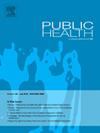The Mexican drug war: Homicides and deaths of despair, 2000–2020
IF 3.9
3区 医学
Q1 PUBLIC, ENVIRONMENTAL & OCCUPATIONAL HEALTH
引用次数: 0
Abstract
Objectives
In 2006, the Mexican government deployed their army on Drug Trafficking Organizations (DTOs). The attempt to remove cartel leaders spurred further conflict between DTOs and led to substantial increases in Mexico's homicide rate. The public display of homicide victims and the media coverage of violence may have elicited feelings of fear and depression, increasing the risk of deaths of despair. We examined whether, in Mexico, homicides correspond positively with region-specific rates of deaths of despair.
Study Design
We applied a fixed effects Poisson count model controlling for population-at-risk, unemployment rates, marriage rates, year indicators, and general seasonality and trend in deaths of despair.
Methods
We utilize data from the National Institute of Statistics, Geography and Informatics to obtain homicides (per 100,000 population) as our exposure and the count of deaths of despair (e.g., alcoholic liver disease, suicide, and drug-related deaths) as our outcome. Our sample size comprised 8064 state-months from 32 Mexican states between 2000 and 2020. We applied a fixed effects Poisson count model controlling for population-at-risk, unemployment rates, marriage rates, year indicators, and general seasonality and trend in deaths of despair.
Results
Homicides (per 100,000 population) correspond with a 1.8 % increase in deaths of despair ([IRR] = 1.018; 95 % CI, 1.007–1.029). When examining type of death, alcoholic liver disease deaths drive this relation with a 1.6 % increase ([IRR] = 1.016; 95 % CI, 1.003–1.030) as a function of homicides (per 100,000 population).
Conclusions
Large and public acts of violence may induce adverse mental health, and in turn, greater deaths of despair (specifically alcoholic liver disease deaths) among Mexican populations not directly connected to homicide-related violence. Prevention efforts should target alcohol misuse and liver disease patients in Mexico.
墨西哥毒品战争:杀人和绝望的死亡,2000-2020
2006年,墨西哥政府部署军队打击贩毒组织(DTOs)。除掉贩毒集团头目的企图进一步刺激了dto之间的冲突,导致墨西哥的谋杀率大幅上升。杀人案受害者的公开展示和媒体对暴力的报道可能引起恐惧和沮丧的感觉,增加了绝望死亡的风险。我们研究了在墨西哥,凶杀案是否与特定区域的绝望死亡率呈正相关。研究设计:我们采用固定效应泊松计数模型,控制高危人口、失业率、结婚率、年度指标以及绝望死亡的一般季节性和趋势。方法:我们利用国家统计、地理和信息学研究所的数据,以凶杀(每10万人)作为我们的暴露量,并以绝望死亡(如酒精性肝病、自杀和与毒品有关的死亡)的数量作为我们的结果。我们的样本量包括2000年至2020年间来自墨西哥32个州的8064个州月。我们应用了固定效应泊松计数模型,控制了高危人口、失业率、结婚率、年度指标以及绝望死亡的一般季节性和趋势。结果凶杀(每10万人)与绝望死亡增加1.8%相对应([IRR] = 1.018;95% ci, 1.007-1.029)。在检查死亡类型时,酒精性肝病死亡导致这一关系增加1.6% ([IRR] = 1.016;95% CI, 1.003-1.030)作为凶杀案的函数(每10万人)。大规模和公开的暴力行为可能导致不良的心理健康,反过来,在墨西哥人口中,更多的绝望死亡(特别是酒精性肝病死亡)与凶杀相关的暴力没有直接关系。墨西哥的预防工作应该针对酒精滥用和肝病患者。
本文章由计算机程序翻译,如有差异,请以英文原文为准。
求助全文
约1分钟内获得全文
求助全文
来源期刊

Public Health
医学-公共卫生、环境卫生与职业卫生
CiteScore
7.60
自引率
0.00%
发文量
280
审稿时长
37 days
期刊介绍:
Public Health is an international, multidisciplinary peer-reviewed journal. It publishes original papers, reviews and short reports on all aspects of the science, philosophy, and practice of public health.
 求助内容:
求助内容: 应助结果提醒方式:
应助结果提醒方式:


